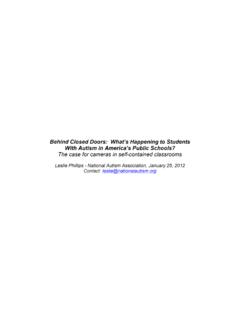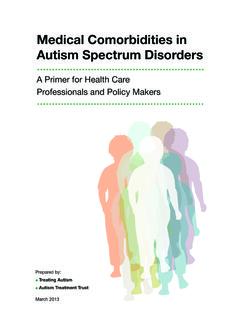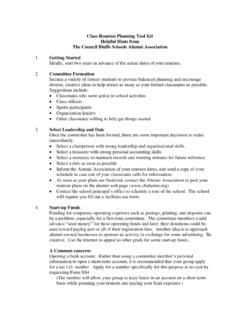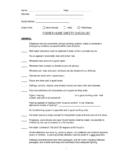Transcription of First Responder Toolkit - …
1 First Responder Toolkit : A Guide to Searching for Missing Persons on the Autism Spectrum education awareness resources Part of the Big Red Safety Box Program brought to you by the National Autism Association July 2017. Table of Contents Purpose 1. First Responder Toolkit : About Autism 2. A Guide to Searching for Missing About Autism & Wandering 3. Persons on the Autism Spectrum Search Checklist 4. Published July 2017 Interaction Tips 5. Emergency Pro le Sheet 6. NCMEC Search Guidelines 7. Copyright 2017, National Autism Association. All rights reserved. The purpose of this guide As a rst Responder , chances are you may encounter one or more individuals who have an Autism Spec- "Sometimes the uniform scares people,". trum Disorder (ASD), a developmental disability that But immediately when I went to the park, can a ect a person's behavior, communication, and she recognized me and she came to me.
2 ". understanding of danger or consequences. The purpose of this guide is to help rst responders Deputy Amanda Vollmer, who helped locate a nonverbal 7-year-old enhance the quality of search-and-rescue response girl who went missing in Nebraska - , August 2016. and interactions with individuals with ASD. Topics Covered In this guide, you will learn about: 1. The Signs of ASD. 2. Unique Safety Risks 3. Where to Search for Someone with ASD. 4. Best Ways to Interact with Someone with ASD. Unique Risks According to 2012 data published in Pediatrics, 49% of children with an ASD attempt to elope from a safe environment, a rate nearly four times higher than their una ected siblings. It's also estimated that individuals with ASD will have seven times more contacts with law enforcement during their lifetimes than the general population (Curry, Posluszny, & Kraska, 1993).
3 ASD behaviors like eye-contact avoidance, not responding to commands, or reacting di erently to sounds, lights and commotion, may be mistaken for de ance, non-compliance or drug/alcohol use and lead to unsafe interactions with members of law enforcement and other rst responders. First Responder Toolkit - National Autism Association, 2017 1. What is Autism? Autism Spectrum Disorder (ASD) is characterized by social-interac- tion di culties, cognitive impairments, communication di culties, and repetitive behaviors. Because autism is a spectrum disorder, no two people with autism are alike. ASD can range from mild to severe and occurs in all ethnic, socioeconomic and age groups. The Centers for Disease Control and Prevention (CDC) estimates that How to Recognize Signs of ASD.
4 An average of 1 in 68 children in the have a diagnosis of ASD. that can cause signi cant social, communication and behavioral A Person with Autism May: challenges. These challenges often present unique safety risks. Not speak Appear deaf Unique Safety Risks Avoid eye contact According to 2012 data published in Pediatrics, 49% of children Not respond to their name or verbal commands with an ASD attempt to elope from a safe environment, a rate Rock, pace, spin or hand- ap (stimming), or repeat nearly four times higher than their una ected siblings. It's also phrases (echolalia). estimated that individuals with ASD will have seven times more Hold hands over ears due to sound sensitivity contacts with law enforcement during their lifetimes than the Avoid or resist physical contact general population (Curry, Posluszny, & Kraska, 1993).
5 ASD behav- Have unusual fears or obsessions with things like iors like eye-contact avoidance, not responding to commands, or ashing lights, sirens, K-9s reacting di erently to sounds, lights and commotion, may be Not answer questions or respond to their name mistaken for de ance, non-compliance or drug/alcohol use and Need time to process questions or demands lead to unsafe interactions. Also be aware that older people with Try to run away or hide Appear to be under the in uence autism may have the mental capacity of someone much younger. Not be properly dressed for the elements Have the mental capacity of someone much Things You Can Do younger To help enhance safety among children and adults with ASD, consider hosting meet and greets or other safety events at your station, a local school, library, park, etc.
6 It would be helpful to collaborate with your local special education director or superin- tendent to schedule school visits. This will allow individuals with ASD to become familiar with your o cers, uniforms, vehicles, and We've noticed a rise in search and rescues with missing [persons with] autism,' said Lieutenant Jim K-9s. You can also start a voluntary registry for members with ASD Byers of the El Dorado County Sheri 's O ce. He in your community and/or tracking programs, such as Project says those incidents spiked in the early 2000's. And in 2005, the Sheri 's O ce launched an autism Lifesaver or SafetyNet Tracking. registry to help.. , March 2017. ? Did you know? Autism is a spectrum disorder. No two people with autism are alike. First Responder Toolkit - National Autism Association, 2017 2.
7 About Autism & Wandering Similar to wandering behaviors in seniors with dementia or "I was able to lay down on the deck and he Alzheimer's, children and adults with ASD are prone to reached out to me and I pulled him up. I just wandering away from safe environments. In fact, nearly half grabbed him, bear hugged him wrapped of children with autism engage in wandering behavior and him in my jacket and took o running.. accidental drowning accounts for 70 to 90% of lethal Patrolman Joshua Leveronne, who rescued a nonverbal 4-year-old boy outcomes. Other dangers include dehydration, heat stroke, from a wastewater treatment pool - , March 2015. hypothermia, tra c injuries, falls, physical restraint, and post-elopement abduction. Key Rescue Component People with ASD may wander or bold from safe settings to First Responder /Rescue crews Good Samaritan Alert System or Reverse 911 Tracking Unit or ID.
8 Get to something of interest, or to get away from something Neighbor stressful, such as loud noises, commotion, or demands. They 3%. 6%. often seek low-sensory environments, or favorite topics or 10%. places. From 2011 to 2016, National Autism Association (NAA). 51%. collected data on over 800 missing person cases involv- 31%. ing individuals with an ASD. Certain results from that data (right & below) could help your department understand where to search for a missing person with ASD, and what components played a role in successful recoveries. Figure 1: Non-lethal outcomes by key rescue component, Mortality & Risk in ASD Wandering/Elopement, NAA, March 2017. Top Places They Were Found Non-lethal Lethal In/near water In/near traf c Woods or brush Stranger's residence Store, restaurant or attraction Train or bus station Abandoned vehicle, home or area On/near train tracks Farm or eld Park 0 40 80 120 160.
9 Figure 2: Non-lethal and lethal outcomes by top places they were located, Mortality & Risk in ASD Wandering/Elopement, NAA, March 2017. First Responder Toolkit - National Autism Association, 2017 3. If Person With Autism is Missing Training & Search Treat each case as critical. Those with autism can have Resources an impaired sense of danger and often go straight to National Center For Missing &. water or tra c. Exploited Children: ; 1-800-THE-LOST. Ask the cargiver if the person wears a personal tracking Project Lifesaver Tracking: device, if so, immediately initiate tracking measures. SafetyNet Tracking: Search Water First ! Even if the child or adult is said to dislike water, search any type of nearby water, includ- ing waste water. Reverse 911: Ask about other dangers that the person may be Autism Risk Management: attracted to; busy roads/highways/construction sites, etc.
10 And immediately dispatch personnel to secure Take Me Home Registry: those areas. O cer Jimmy Donohoe .us Ask about individual's likes that may assist in search EMA Emergency Alert Guidelines: e orts Will they be drawn to certain music, favorite characters, re trucks, mom's voice, etc. Prevention Resources Ask about individual's dislikes and fears or sensory for Families issues that may hinder search e orts. (Dogs, Sirens, Aircraft, Lights, Shouting.) National Autism Association Ask if the individual will respond to his/her name when NAA's Big Red Safety Box called. AWAARE Collaboration Implement Reverse 9-1-1 (Visit for details.). Issue an Endangered Missing Alert. We're ecstatic we found this kid with everything stacked against us.. Capt. Jones, who helped locate a nonverbal 7-year-old boy in a riverbed after an eight-hour search - ModBee, January 2014.









